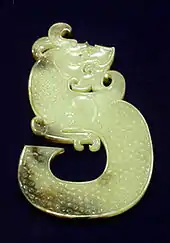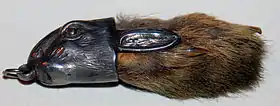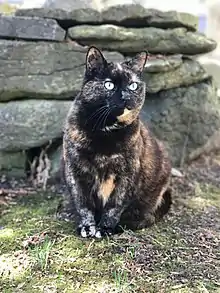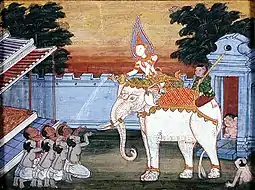List of lucky symbols
This is a list of lucky symbols, signs, and charms. Luck is symbolized by a wide array of objects, numbers, symbols, plant and animal life which vary significantly in different cultures globally. The significance of each symbol is rooted in either folklore, mythology, esotericism, religion, tradition, necessity or a combination thereof.
| Symbol | Culture | Notes | |
|---|---|---|---|
| 7 |  |
Western | [1][2] |
| 8 |  |
Chinese | Sounds like the Chinese word for "fortune". See Numbers in Chinese culture#Eight |
| Aitvaras | Lithuania | ||
| Albatross | .png.webp) |
Considered a sign of good luck if seen by sailors.[3][4] | |
| Amanita muscaria | |||
| Ashtamangala |  |
Indian religions such as Hinduism, Jainism, and Buddhism | Buddhism: Endless knot, Lotus flower, Dhvaja, Dharmachakra, Bumpa, Golden Fish, Parasol, Conch; additional symbols for Hinduism and Jainism |
| Bamboo |  |
Chinese | [5] |
| Barnstar |  |
United States | [6][7] |
| Chimney sweep | .jpg.webp) |
Many parts of the world | Said to bring good luck when being touched, especially on New Year and on weddings. |
| Corno portafortuna |  |
Central and Southern Italy | |
| Ladybugs |  |
German, Italian, Russian, Turkish, Serbia (Srbija) | There is an old children's song in Serbia "Let, let, bubamaro, donesi mi sreću" meaning "Fly, fly, ladybug, bring me the happiness". In Serbian, "sreća" means "good chances" as in a lottery or "happiness", but this is about emotions. |
| Dreamcatcher |  |
Native American (Ojibwe) | [8][9] |
| Fish |  |
Chinese, Hebrew, Ancient Egyptian, Tunisian, Indian, Japanese | [10][11][12][13][14][15] |
| Bird or flock going from right to left | Paganism | Auspicia | |
| A monk passing through |  |
Buddhist | |
| Four-leaf clover |  |
Irish and Celtic, German | [16][17] |
| Shamrock or Clover |  |
Irish | While in most of the world, only the four-leafed clover is considered lucky, in Ireland all Irish Shamrocks are. |
| Horseshoe |  |
English and several other European ethnicities | Horseshoes are considered lucky when turned upwards but unlucky when turned downwards, although some people believe the opposite.[18][19] |
| Jade |  |
Chinese | |
| Maneki-neko |  |
Japanese, Chinese | Often mistaken as a Chinese symbol due to its usage in Chinese communities, the Maneki-neko is Japanese. |
| Pig |  |
Chinese, German | [20] |
| Rabbit's foot |  |
North America, England and Wales (originating from a hare's foot) | A rabbit's foot can be worn or carried as a lucky charm.[21] |
| Wishbone |  |
Europe, North America | [22] |
| Sarimanok |  |
Maranao | |
| Swallow |  |
Korea | Rooted in Folktale 'Heungbu and Nolbu' |
| Tortoise shell cat |  |
Many cultures | Rooted in Folklore |
| White Elephant |  |
Thai | [23] |
| White heather | Irish Travellers, Scotland | ||
| Jew with a coin | Poland | Thought to bring money. [24][25][26] | |
See also
Notes
- Dolnick and Davidson, p. 85
- Greer, p. 21
- Webster, p. 6
- Dodge, p. 748
- Parker, p. 150
- Urbina, Eric (July 22, 2006). "For the Pennsylvania Dutch, a Long Tradition Fades". The New York Times. Retrieved April 26, 2011.
- Votruba, Cindy (September 8, 2008). "It's in the Stars". Marshall Independent. Retrieved April 26, 2011.
- Young, Eric (February 2, 1998). "New Age Solution for Coping with Material-world Tension". The Sacramento Bee. ProQuest 246401007.
- Thrall, Christopher (September 17, 2005). "Objects in the mirror may be more complex than they appear". Postmedia News. ProQuest 460167802.
- Helfman, p. 400
- Marks, p. 199
- Toussaint-Samat, p. 311
- Hackett, Smith, & al-Athar, p. 218
- Sen, p. 158
- Volker, p. 72
- Dolnick and Davidson, p. 38
- Binney, p. 115
- Cooper, p. 86
- DeMello, p. 35
- Webster, p. 202
- Webster, p. 212
- Edward A. Armstrong."The Folklore of Birds" (Dover Publications, 1970)
- "'Lucky' white elephant for Burma". BBC News. November 9, 2001.
- Tartakowsky, Ewa. "Le Juif à la pièce d’argent." La vie des idées (2017).
- The Jew with a Coin: Analysis of a contemporary folkloric emblem (AAPJ), Joanna Tokarska-Bakir, 2019.
- Driving to Treblinka: A Long Search for a Lost Father, Diana Wichtel, 2018, Awa Press, page 144. link to extract from book in Nzherald, published 16 May 2018
Sources
- Becker, Udo (2000). The Continuum Encyclopedia of Symbols. Continuum International Pub. ISBN 0-8264-1221-1. OCLC 461363881.
- Bessant, Claire (1999). Cat: The Complete Guide. Barnes & Noble. ISBN 0-7607-1718-4. OCLC 43543102.
- Binney, Ruth (2006). Nature's Ways: Lore, Legend, Fact and Fiction. David & Charles. ISBN 0-7153-2417-9. OCLC 70059876.
- Chapman, Mark (2004). "Nominally Chinatown". Reed College Luce Chinese Studies Grants. Retrieved April 26, 2011.
- Cioccolanti, Steve (2010). From Buddha to Jesus: An Insider's View of Buddhism and Christianity. Monarch Books. ISBN 978-1-85424-956-2. OCLC 455828844.
- Cooper, Jean C. (1978). An Illustrated Encyclopaedia of Traditional Symbols. Thames and Hudson. ISBN 0-500-27125-9. OCLC 61763660.
- DeMello, Margo (2009). Feet and Footwear: A Cultural Encyclopedia. MacMillan. ISBN 978-0-313-35714-5. OCLC 318420875.
- Dodge, Mary Mapes (1910). St. Nicholas. 37. Scribner & Co.
- Dolnick, Barrie; Davidson, Anthony H. (2007). Luck: Understanding Luck and Improving the Odds. Random House. ISBN 978-0-307-34750-3. OCLC 122309479.
- Eberhard, Wolfram (1986). A Dictionary of Chinese Symbols: Hidden Symbols in Chinese Life and Thought. Psychology Press. ISBN 0-415-00228-1. OCLC 18416687.
- Greer, Brian (2009). Culturally Responsive Mathematics Education. Taylor & Francis. ISBN 978-0-8058-6263-8. OCLC 262422858.
- Hackett, Olwen; Smith, D.J.; al-Athar, Maslahat (1984). Ghirza: A Libyan Settlement in the Roman Period. Dept. of Antiquities. OCLC 18457072.
- Hanson, James Austin (1994). Spirits in the Art: From the Plains and Southwest Indian Cultures. Lowell Press. ISBN 0-932845-66-5. OCLC 30859981.
- Helfman, Gene S. (2007). Fish Conservation: A Guide to Understanding and Restoring Global Aquatic Biodiversity and Fishery Resources. Island Press. ISBN 978-1-55963-595-0. OCLC 80180254.
- Iversen, Edwin (1996). Living Marine Resources: Their Utilization and Management. Springer. ISBN 0-412-98741-4. OCLC 32468091.
- Long, Michael (1989). "Symbol and Ritual in Josquin's Missa di Dadi". Journal of the American Musicological Society. University of California Press. 42 (1): 1–22. doi:10.1525/jams.1989.42.1.03a00010. ISSN 0003-0139. JSTOR 831416. OCLC 477562339.
- Marks, Gil (2010). Encyclopedia of Jewish Food. John Wiley & Sons. ISBN 978-0-470-39130-3. OCLC 501320645.
- Parker, Barbara (2005). Introduction to Globalization and Business: Relationships and Responsibilities. SAGE. ISBN 0-7619-4495-8. OCLC 60559232.
- Sen, Colleen Taylor (2004). Food Culture in India. Greenwood Pub. ISBN 0-313-32487-5. OCLC 55475094.
- Volker, T. (1950). The Animal in Far Eastern Art and Especially in the Art of the Japanese Netsuke, with References to Chinese Origins, Traditions, Legends, and Art. BRILL. ISBN 9004042954. OCLC 600653239.
- Webster, Richard (2008). The Encyclopedia of Superstitions. Llewellyn Worldwide. ISBN 978-0-7387-1277-2. OCLC 173748226.
- Welch, Patricia Bjaaland (2008). Chinese Art: A Guide to Motifs and Visual Imagery. Tuttle Publishing. p. 231. ISBN 978-0-8048-3864-1. OCLC 154701519.
This article is issued from Wikipedia. The text is licensed under Creative Commons - Attribution - Sharealike. Additional terms may apply for the media files.